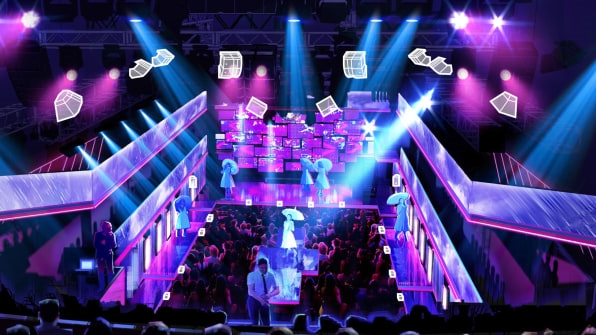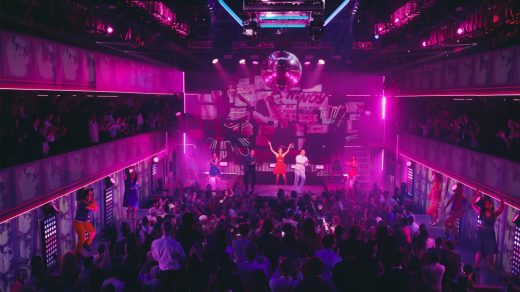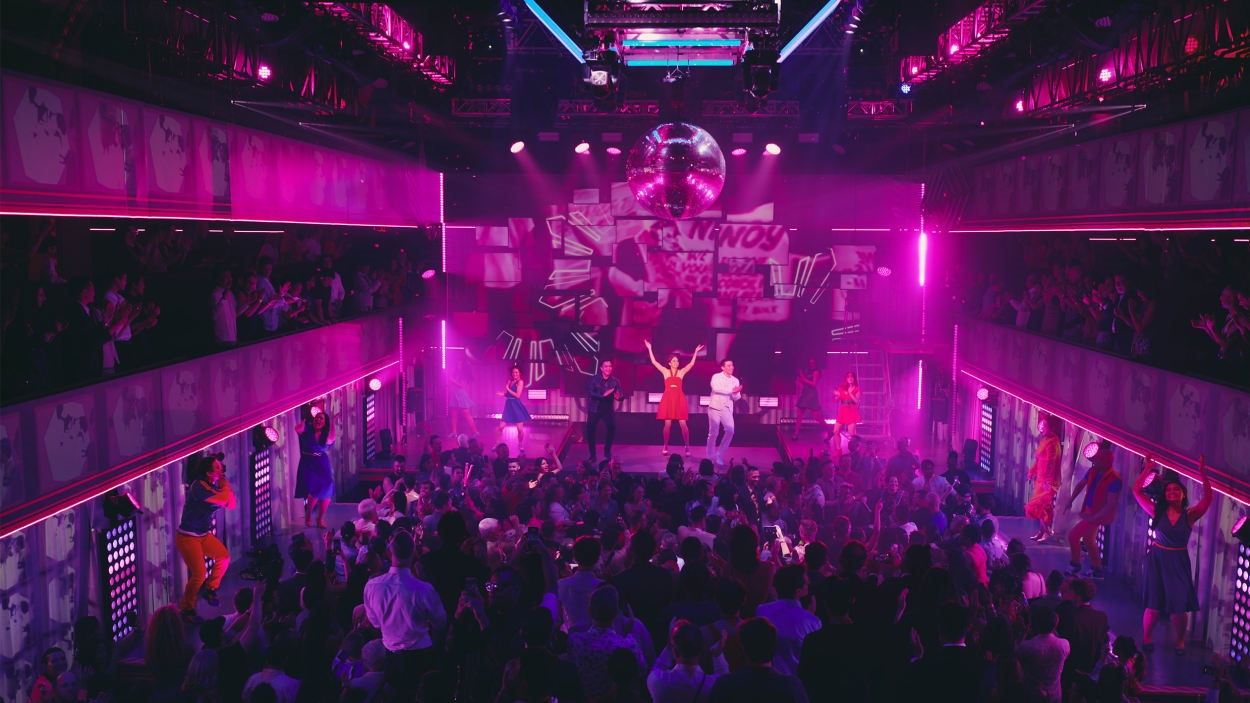Spatial audio is the head-turning secret to the sound of David Byrne’s new Broadway musical
Following a preview performance of Here Lies Love late last month, Cody Spencer, one of the show’s sound designers, led a group around the spacious Broadway Theatre in Midtown Manhattan to offer a detailed technical breakdown of the production.
His job was not to explain what we’d just seen. That was apparent amid the glut of media coverage about the pop-infused Broadway musical, which was written by David Byrne and Fatboy Slim, and follows the notorious life of former Philippines first lady Imelda Marcos. Much had already been made about the show’s astounding visual breakthroughs, how set designer David Korins ripped out the seats of the theater’s orchestra section and transformed the front of the house into a pulsating dance club; how reinforcements were constructed under the theater floor to keep it from buckling under the weight of hundreds of attendees doing the pogo in unison; how the high-concept staging was itself an homage to Philippine nightlife and the thriving karaoke culture that fuels it.
Rather, Spencer was on hand after the performance to reveal something less obvious: the hidden technical wizardry and state-of-the-art hardware behind the musical’s immersive sound, a feat made possible by the latest advances in spatial audio and “object-based processing tools,” which gave audience members a sense of being submerged in music from all directions. Imagine a scene in which Imelda Marcos and her authoritarian husband, Ferdinand, belt out songs from opposite ends of the room. While physics might prevent you from being be able to watch them both at the same time, your ears know exactly where their voices are coming from.
To achieve this effect, Spencer pointed out, more than 200 loudspeakers were placed throughout six different zones in the theater. During that night’s performance, the venue happened to be packed with theater critics, influencers, and other high-stakes attendees, including a smattering of celebrities that included Whoopi Goldberg, Jesse Tyler Ferguson, and even Byrne himself.
It’s a lot of pressure to have the show’s creator in the audience two days before the official press opening, but Spencer did not appear nervous as he gave his post-performance demonstration. He showed complete confidence in the audio technology and its ability to power a complex live musical, even in the event of some unforeseen technical snafu.
“There are a lot of redundancies,” he observed, not that we could hear anyone complaining over the flawless execution of the mix.

Can you hear the people sing?
The audio achievements in Here Lies Love were made possible by L-Acoustics, a French sound-tech company that has been pushing the envelope in live concert experiences since 1984. The thumping club music and voices of the cast were thrust into lush life with the help of a state-of-the-art mixer and sound system that the company has named L-ISA (pronounced el-eesa). The centerpiece is a high-octane processor that can read up to 96 different audio objects as they move about—or dance brilliantly—in an elaborate and constantly changing 360-degree environment.
“Any sound object that happens to be within a range that we’ve defined—whether it is very narrow or the full 360-degree area—can get automatically mixed down, essentially, to these different other output formats,” explains Jordan Tani, a product and technology marketing engineer at L-Acoustics. “L-ISA sound inputs could be a combination of cast, live instruments, playback tracks, and so on and so forth, and then you can manipulate them.”
Here Lies Love was not an easy show to bring to life, and, in fact, its intricate scenic design was precisely what made L-ISA the perfect solution, Tani adds. In addition to the dance floor, the six zones in the theater included two floor-side seating areas, a VIP seating area, the front mezzanine, the rear mezzanine, and the mix position, which is just offstage under the DJ.
“The nature of this show makes it very complex,” says Tani. “Standard proscenium-style shows can be a lot more simple in terms of execution because we might be dealing with just one space instead of six.”
L-ISA began about a decade ago as a project spearheaded by L-Acoustics founder Christian Heil, who has a PhD in particle physics and is known for pioneering the line-array sound systems that are now an industry standard at live events. Heil had noticed that the sound quality at live shows would differ depending on where he was sitting in the physical space, so he envisioned a system that could deliver high-quality sound to everyone at a live event, regardless of whether or not they had the most expensive seats in the house.
“At its simplest, the mission statement of L-ISA is to connect what you hear with what you see visually,” Tani says. “So it’s to get that 5% sweet spot that you have at the center of your couch at home, or that 5% sweet spot when you’re the mixer at a live show, and give that experience to almost every single person in the audience.”
The technology, he adds, was developed in a “secret basement” at the company’s headquarters in Marcoussis, France. It made its public debut in 2016 at the Jazz à la Villette festival in Paris, and has since evolved with each new upgrade to be able to handle more complex, immersive configurations.
Louder than words
In a way, L-ISA’s evolution mirrors that of Here Lies Love, which began as a concept album and was later adapted to a stage musical, premiering about a decade ago at the Off-Broadway Public Theater. Spencer, the sound designer, was working on an earlier incarnation of the show right around the time that L-ISA was in its research and development phase. He learned about the technology from L-Acoustics product manager Scott Sugden, a friend, who invited Spencer down to the secret basement to hear what it could do. Spencer thought it had potential for Here Lies Love, which required a lot of technical spatial setups even during its Off-Broadway incarnations.
Fast-forward to July 2023. Here Lies Love and L-ISA have both just made their Broadway debuts at a venue that might pose an almost poetic challenge. The 1,761-seat Broadway Theatre, one of the largest houses on Broadway, has in recent years showcased some very ambitious, if not commercially successful, works. These include the 2018 musical King Kong, which today is mostly remembered for its 20-foot marionette, and Ivo van Hove’s multimedia revival of West Side Story, which closed during the pandemic and never reopened after its top producer, Scott Rudin, stepped away from the business amid accusations of workplace bullying.
Here Lies Love has seen its own share of controversy, most notably due to its use of pre-recorded music, which a musician’s union said was in defiance of the venue’s contract. (The show eventually agreed to hire more live musicians.) The subject matter, meanwhile, is not everyone’s idea of ideal fodder for a stage musical, and the show has been accused of glorifying a brutal regime, although the producers have said it is “anti-Marcos.”
For those willing to overlook any perceived strikes against it, they will be treated to something truly distinctive, courtesy of a talented all-Filipino cast—a first for Broadway—plenty of fun numbers, and even a few genuinely touching moments. At times, it’s almost too much stimuli for any single evening to contain; but if you listen closely, you’ll always know just where to look.
Which, of course, is the point. “You hear [someone’s voice], and then another cast member sings in a different direction, and every single person’s head turns,” recalls Tani. “It’s so fascinating to see because it’s not being directed by a lighting or a visual cue. It’s just because you’re pulled by the sound.”
(22)



